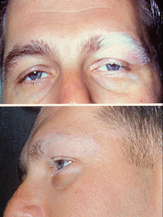Vogt-Koyanagi-Harada syndrome
| Vogt-Koyanagi-Harada syndrome | |
 | |
|---|---|
| ICD-10 | H20.8 |
| ICD-9 | 364.24 |
| DiseasesDB | 13983 |
| eMedicine | derm/739 |
| MeSH | D014607 |
Please Join in Editing This Page and Apply to be an Editor-In-Chief for this topic: There can be one or more than one Editor-In-Chief. You may also apply to be an Associate Editor-In-Chief of one of the subtopics below. Please mail us [1] to indicate your interest in serving either as an Editor-In-Chief of the entire topic or as an Associate Editor-In-Chief for a subtopic. Please be sure to attach your CV and or biographical sketch.
Overview
Vogt-Koyanagi-Harada syndrome (VKH syndrome) is a condition seen in humans and dogs involving various melanocyte-containing organs, characterized by uveitis (inflammation of the inside of the eye), poliosis (whitening of hair), vitiligo (loss of pigment in the skin), and meningitis, although dogs with this syndrome rarely develop meningitis. It is also known as uveodermatologic syndrome. VKH syndrome is an immune-mediated disease.
The mechanism of the disease is thought to be T helper cell mediated autoimmune attack of melanocytes in the skin and uvea of dogs and humans, and in the central nervous system and inner ear of humans.[1]
In humans there is a higher rate of VKH syndrome in people of Asian, Latin, and Mediterranean descent.[2]
VKH syndrome in dogs
In dogs VKH syndrome (often called VKH-like syndrome) most commonly affects young animals and is seen most commonly in the Akita Inu, but also in the Siberian Husky and Samoyed.[2] Uveitis usually occurs first and is often severe enough to cause blindness.
VKH syndrome can also cause retinal detachment, cataracts, and glaucoma.
Pigment partly disappears from the retinal pigment epithelium and iris. Skin lesions include loss of pigment and hair on the eyelids, nose, and lips.
Symptoms and biopsy will confirm the diagnosis. Treatment is with immunosuppressive drugs such as prednisone and azathioprine. The prognosis is guarded.[2]
References
- ↑ Sigle K, McLellan G, Haynes J, Myers R, Betts D (2006). "Unilateral uveitis in a dog with uveodermatologic syndrome". J Am Vet Med Assoc. 228 (4): 543–8. PMID 16478427.
- ↑ 2.0 2.1 2.2 Gelatt, Kirk N. (ed.) (1999). Veterinary Ophthalmology (3rd ed. ed.). Lippincott, Williams & Wilkins. ISBN 0-683-30076-8.